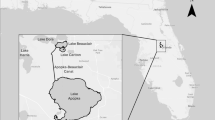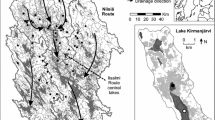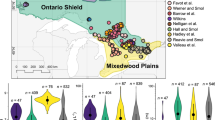Abstract
Since European settlement began over 200 years ago, many southeast Australian coastal lakes and lagoons have experienced substantial human impacts, including nutrient enrichment. Present day management and conservation efforts are often hampered by a lack of data on pre-impact conditions. We used a palaeoecological approach at Lake King, Gippsland Lakes, southeast Australia in order to determine its pre-impact condition and to establish the nature and direction of subsequent environmental changes, including responses to the construction of a permanent entrance to the sea in 1889. A 120 cm sediment core was analysed for diatoms, chlorophyll a, total carbon, nitrogen and sulphur, and dated using 210Pb. Past phosphate and salinity concentrations were reconstructed using diatom-phosphate and diatom-salinity transfer functions developed from a calibration set based on 53 sites from 14 southeast Australian coastal lakes and lagoons. Results show changes in the diatom assemblage that record a shift from a brackish-water to marine diatom flora since construction of the permanent entrance. Phosphate concentrations increased at the same time and experienced major peaks in the 1940s and 1950s to >100 μg/l. Chlorophyll a concentrations were generally below 24 μg/l/gTOC in the core, but there has been a clear increase since the 1980s, peaking at 120 μg/l/gTOC, likely associated with a recorded increase in the frequency of nuisance algal blooms. These results indicate that the Lake King environment is now very different to that present during early European settlement. We conclude that by identifying the nature and direction of environmental change, palaeoecological studies can contribute towards developing realistic and well-informed management, conservation and restoration strategies in Australian coastal ecosystems.








Similar content being viewed by others
References
Andersen JH, Conley DJ, Hedal S (2004) Palaeoecology, reference conditions and classification of ecological status: the EU Water Framework Directive in practise. Mar Pollut Bull 49:283–290
Appleby PG (2001) Chronostratigraphic techniques in recent sediments. In: Last WM, Smol JP (eds) Tracking environmental change using lake sediments, vol 1. Kluwer Academic Publishers, Dordrecht, pp 171–203
Appleby PG, Oldfield F (1978) The calculation of 210Pb dates assuming a constant rate of supply of unsupported 210Pb to the sedi ment. Catena 5:1–8
Appleby PG, Oldfield F (1992) Application of lead-210 to sedimentation studies. In: Ivanovich M, Harmon RS (eds) Uranium-series disequilibrium: applications to earth, marine and environmental sciences. Oxford University Press, New York, pp 731–778
Battarbee RW, Jones VJ, Flower RJ, Cameron NG, Bennion H, Carvalho L, Juggins S (2001) Diatoms. In: Smol JP, Birks HJB, Last WM (eds) Tracking environmental change using lake sediments: terrestrial, algal and siliceous indicators, vol 3. Kluwer Academic Publishers, Dordrecht, pp 155–202
Bird ECF (1965) A geomorphological study of the Gippsland Lakes. Australian National University, Canberra
Bird ECF (1993) The coast of Victoria: the shaping of scenery. Melbourne University Press, Melbourne
Bradshaw EG, Nielsen AB, Anderson NJ (2006) Using diatoms to assess the impacts of prehistoric, pre-industrial and modern land-use on Danish lakes. Reg Environ Change 6:17–24
Brodie J (1995) The problems of nutrients and eutrophication in the Australian marine environment. In: Zann LP, Sutton D (eds) State of the marine environment report for Australia. Technical annex 2 – State and Territory issues. Great Barrier Reef Marine Park Authority for the Department of Environment, Sport and Territories Ocean Rescue 2000 Program, Townsville, pp 1–29
Clarke A, Juggins S, Conley D (2003) A 150-year reconstruction of the history of coastal eutrophication in Roskilde Fjord, Denmark. Mar Pollut Bull 46:1615–1629
Davis JR, Koop K (2006) Eutrophication in Australian rivers, reservoirs and estuaries: a southern hemisphere perspective on the science and its implications. Hydrobiologia 559:23–76
Dean WE (1974) Determination of carbonate and organic matter in calcareous sediments and sedimentary rocks by loss on ignition, comparison with other models. J Sediment Petrol 44:242–248
Ellegaard M, Clarke A, Reuss N, Drew S, Weckström K, Juggins S, Anderson NJ, Conley DJ (2006) Multi-proxy evidence of long-term changes in ecosystem structure in a Danish marine estuary, linked to increased nutrient loading. Estuar Coast Shelf Sci 68:567–578
Environment Australia (2005) Australia’s Ramsar sites. Department of the Environment and Heritage (available from http://www.environment.gov.au/water/wetlands/index.html). Cited Nov 2005
Gelen A, Diaz O, Simon MJ, Herrera E, Soto J, Gomez J, Rodenas C, Beltran J, Ramirez M (2003) 210Pb dating of sediments from Havana Bay. J Radioanal Nucl Chem 256:561–564
Goldberg ED (1963) Geochronology with lead-210. In: Radioactive dating. IAEA, Vienna, pp 121–131
Harris GP (1999) Comparison of biogeochemistry of lakes and estuaries: ecosystem processes, functional groups, hysteresis effects and interactions between macro- and microbiology. Mar Freshwat Res 50:791–811
Harrison J, Heijnis H, Caprarelli G (2003) Historical pollution variability from abandoned mine sites, Greater Blue Mountains World Heritage Area, NSW, Australia. Environ Geol 43:680–687
Harvey N, Caton B (2003) Coastal management in Australia. Oxford University Press, South Melbourne
Hodgson DA, Tyler PA, Vyverman W (1996) The palaeolimnology of Lake Fidler, a meromictic lake in south west Tasmania and the significance of recent human impact. J Paleolimnol 18:313–333
Hodgson DA, Vyverman WG, Tyler PA (1997) Diatoms of meromictic lakes adjacent to the Gordon River, and of the Gordon River estuary in south-west Tasmania. In: Lange-Berlot H, Kociolek P (eds) Bioliotheca Diatomologica Band 35. Gebruder Borntraeger, Berlin
Hodgson DA, Wright SW, Tyler PA, Davies N (1998) Analysis of fossil pigments from algae and bacteria in meromictic Lake Fidler, Tasmania, and its application to lake management. J Paleolimnol 19:1–22
Holm-Hansen O, Lorenzen CJ, Holmes RW, Strickland JDH (1965) Fluorometric determination of chlorophyll. Journal du Conseil Permanent International Pour L’Exploration de la Mer 30:3–15
John J (1983) The diatom Flora of the Swan River Estuary Western Australia, vol 64. Bibliotheca Phycologica, Vaduz
Juggins S (2003) C2 User Guide. Software for ecological and palaeoecological data analysis and visualisation. University of Newcastle, Newcastle Upon Tyne, United Kingdom
Kemp WM, Boynton WR, Adolf JE, Boesch DF, Boicourt WC, Brush G, Cornwell JC, Fisher TR, Glibert PM, Hagy JD, Harding LW, Houde ED, Kimmel DG, Miller WD, Newell RIE, Roman MR, Smith EM, Stevenson JC (2005) Eutrophication of Chesapeake Bay: historical trends and ecological interactions. Mar Ecol Prog Ser 303:1–29
McGlathery KJ, Berg P, Marino R (2001) Using porewater profiles to assess nutrient availability in seagrass-vegetated carbonate sediments. Biogeochemistry 56:239–263
McMinn A, Hallegraeff GM, Thomson P, Jenkinson AV, Heijnis H (1997) Cyst and radionucleotide evidence for the recent introduction of the toxid dinoflagellate Gymnodinium catenatum into Tasmanian waters. Mar Ecol Prog Ser 161:165–172
McMinn A, Heijnis H, Murray A, Hallegraeff GM (2004) Diatom and dinoflagellate assemblages of the Hawkesbury River, N.S.W., over the last two centuries: evidence for changes in hydrology. Alcheringa 28:505–514
MOLTEN (2004) Monitoring long-term trends in eutrophication and nutrients in the coastal zone (available from http://www.Craticula.ncl.ac.uk/Molten/jsp/)
NWQMS (2000) Australian and New Zealand guidelines for fresh and marine water quality. Australian and New Zealand Environment and Conservation Council, Canberra (available from http://www.environment.gov.au/water/quality/nwqms/index.html). Cited Aug 2006
R Development Core Team (2006) R: a language and environment for statistical computing. R Foundation for Statistical Computing, Vienna, Austria. ISBN 3-900051-07-0 (available from http://www.R-project.org)
Robbins JA (1978) Geochemical and geophysical applications of radioactive lead. In: Nriagu JO (ed) Biogeochemistry of lead in the environment. Elsevier Scientific, Amsterdam, pp 285–393
Saunders KM, McMinn A, Roberts D, Hodgson DA, Heijnis H (2007) Recent human-induced salinity changes in Ramsar-listed Orielton lagoon, southeast Australia. Aquat Conserv: Mar Freshwat Ecosyst 17:51–70
SoE (2006) State of the Environment Report (available at http://www.environment.gov.au/soe/2006/). Cited Jan 2007
Sonneman JA, Sincock A, Fluin J, Reid MA, Newall P, Tibby JC, Gell PA (2000) An illustrated guide to common stream diatom species from temperate Australia. Cooperative Research Centre for Freshwater Ecology, Albury
Stephens A, Biggins N, Brett S (2004) Algal bloom dynamics in the estuarine Gippsland Lakes. Scientific Report, Victorian Environment Protection Agency
Taffs KH (2005) Diatoms of northern New South Wales, Australia. Unpublished dataset. Southern Cross University, Australia
Taffs KH, Farago L, Heijnis H, Jacobsen G (in press) A diatom-based Holocene record of human impact from a coastal environment, eastern Australia. J Paleolimnol 26 pp
Telford RJ, Birks HJB (2005) The secret assumption of transfer functions: problems with spatial autocorrelation in evaluating model performance. Quat Sci Rev 24(20–21):2173–2179
ter Braak CJF, Smilauer P (2002) CANOCO Reference manual and CanoDraw for Windows user’s guide: software for canonical community ordination (version 4.5). Microcomputer Power, Ithaca, New York
Tibby JC (2004) Development of a diatom-based model for inferring total phosphorus in southeastern Australian water storages. J Paleolimnol 31:23–36
Vaalgamaa S, Korhola A (2004) Searching for order in chaos: a sediment stratigraphy study of a multiple-impacted bay of the Baltic Sea. Estuar Coast Shelf Sci 59:319–332
Webster IT, Harris GP (2004) Anthropogenic impacts on the ecosystems of coastal lagoons: modelling fundamental biogeochemical processes and management implications. Mar Freshwat Res 55:67–78
Webster IT, Parslow JS, Grayson RB, Molloy R, Andrewartha J, Sakov P, Seong Tan K, Walker SJ (2001) Gippsland Lakes environmental study: assessing options for improving water quality and ecological function. Final report, November 2001. CSIRO, Glen Osmond, South Australia
Weckström K, Juggins S, Korhola A (2004) Quantifying background nutrient concentrations in coastal waters: a case study from an urban embayment of the Baltic Sea. Ambio 33:324–327
Weckström K (2006) Assessing recent eutrophication in coastal waters of the Gulf of Finland (Baltic Sea) using subfossil diatoms. J Paleolimnol 35:571–592
Weckström K, Juggins S (2006) Coastal diatom-environment relationships from the Gulf of Finland, Baltic Sea. J Phycol 42:21–35
Winstanley R (1995) Issues in the Victorian marine environment. In: Zann LP, Sutton D (eds) State of the marine environment report for Australia. Technical annex 3 – State and Territory issues. Great Barrier Reef Marine Park Authority for the Department of Environment, Sport and Territories Ocean Rescue 2000 Program, Townsville, pp 13–37
Witkowski A, Lange-Berlot H, Metzeltin D (2000) Diatom flora of marine coasts. In: Lange-Berlot H (ed) Iconographica Diatomologica: annotated diatom micrographs, vol 7. A. R. G. Ganter Verlag K. G., Berlin
Acknowledgements
This study was funded by an Australian Postgraduate Award, awarded to Krystyna Saunders, with additional funding from the Australian Institute of Nuclear Science and Engineering, and Project Aware. We would like to thank Steve Juggins and Richard Telford for advice on statistical analyses and Kathryn Taffs and Kaarina Weckström for project advice and taxonomic assistance. We would also like to thank Chris Barry, Andy Longmore and Simon Roberts for advice on current Gippsland Lakes management and providing local knowledge, and Robert Chisari, Anthony Cowles, Kate Dziegielewska, Sarah Lovibond and Jessie Webb for field assistance.
Author information
Authors and Affiliations
Corresponding author
Rights and permissions
About this article
Cite this article
Saunders, K.M., Hodgson, D.A., Harrison, J. et al. Palaeoecological tools for improving the management of coastal ecosystems: a case study from Lake King (Gippsland Lakes) Australia. J Paleolimnol 40, 33–47 (2008). https://doi.org/10.1007/s10933-007-9132-z
Received:
Accepted:
Published:
Issue Date:
DOI: https://doi.org/10.1007/s10933-007-9132-z




